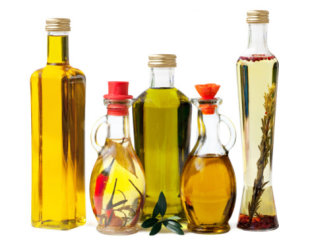5 Oils Every Pantry Should Have

A well-stocked pantry should include a five basic oils to make recipes sing. Read on as Kalena Ross decodes the rainbow of bottles on grocery store shelves:
1) Canola Oil
Canola Oil is said to be one of the healthiest cooking oils due to its low saturated fat content. Plus, a hefty dose of omega-3s also keeps hair and skin looking nourished. Surprisingly, the canola seed used to make the oil is actually a cousin to veggie powerhouses cabbage and Brussels sprouts.
Why it will help that heart of yours: Its high monounsaturated fat levels help reduce blood cholesterol levels and it is a rich source of vitamin E.
Seasonal must-cook recipes: Commonly used for frying, canola oil creates crisp textures and its light flavor doesn't mess with the taste of pies and cakes. Go ahead and get sinful (in moderation!) with this Deep Fried Oreo recipe and sub in canola oil.
2) Olive Oil
Olive oil is one of the most common oils on shelves for a reason; it's a delicate, versatile oil, high in monounsaturated fats, which you can drizzle unheated on just about anything. Remember olive oil comes from a fruit (yep, olives are technically fruit), so air, heat and light will cause it to go bad. Keep it in the cupboard, away from heat and sunlight.
Why it will help you live longer: It's loaded with polyphenols, which are natural anti-oxidants that can prevent heart disease, and lower cholesterol and blood pressure.
Seasonal must-cook recipes: Olive oil is one of the secrets to the super-healthy Mediterranean diet. It tends to be the best oil to use in salad dressings, for drizzling over cheese, or for any Mediterranean-inspired dish. Dig into this Bruschetta with Rosemary, Roasted Plum Tomatoes, Ricotta and Prosciutto recipe and finish it by drizzling extra virgin olive oil over the top.
3) Peanut Oil
You probably guessed that this oil comes from peanuts, a staple in Asian cuisines. It often has a light nutty flavor and is a great frying oil because it does not absorb the flavors of other foods.
Why it's heart-healthy: It is trans fat-free and low in saturated fats.
Seasonal must-cook recipes: Great for light sautéing and deep-frying, peanut oil is your go-to for Southeast Asian stir-fries. Grab your wok and try Epicurious' Spicy Stir Fried Chicken and Greens with Peanuts recipe. On movie night, we love to use it to pop our corn!
4) Grapeseed Oil
Extracted from the crushed seeds of grapes, grapeseed oil is a byproduct of the wine industry. Grapeseed oil is very light in taste and can be a replacement for olive oil because it can withstand higher temperatures.
For a health boost: You'll get some of the same cardiovascular health benefits from grapeseed oil as you will from a glass of red wine, so swap out your nightly glass of vino for a serving of the oil instead.
Seasonal must-cook recipes: Before you sauté veggies, toss them in this oil. Virtually flavorless, grapeseed oil allows the fresh flavor of spring and summer produce to shine. On a hot day this summer, cool down with this Pan-Roasted Sea Bass with Citrus and Avacado recipe.
5) Walnut Oil
Walnut Oil packs a punch when it comes to its nutty taste, but be wary of heating it, as it doesn't perform well at high temps.
Same benefits as walnuts, but less calories: Walnut oil is jam packed with alpha-linolenic acid, a heart health, anti-inflammatory omega-3. Women especially will want to note that it's high in vitamin K, which is great for strengthening bones.
Seasonal must-cook recipes: Walnut oil is best used uncooked in cold sauces, sprinkled over salad greens or tossed with pasta. We're big on using it in our dessert recipes to take advantage of its nutty flavor. For a uniquely delicious dessert, roast grapes in walnut oil, serve with vanilla yogurt and top with cinnamon. How easy is that?

No comments:
Post a Comment